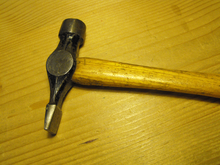The Warrington hammer is a common woodworking tool that falls under the cross-peen category of hammers. The chisel-like cross-peen side of the hammer is used to set small nails and pins while the smaller, rounded face is used to finish driving in the aforementioned nail. The cross-peen side of the tool is also used for refining work, such as furniture and cabinet making. While the standard claw hammer would be more used for tasks that involve greater use of force, the Warrington hammer is preferred for projects that require precision, hence its prevalence in the art of woodworking. The most common length of a standard Warrington hammer is around 12+1⁄2 inches (320 mm) in length with the hammer head weighing between 10 and 14 ounces (280 and 400 g).[1][2]
 | |
| Other names |
|
|---|---|
| Classification | Woodworking hand tool |